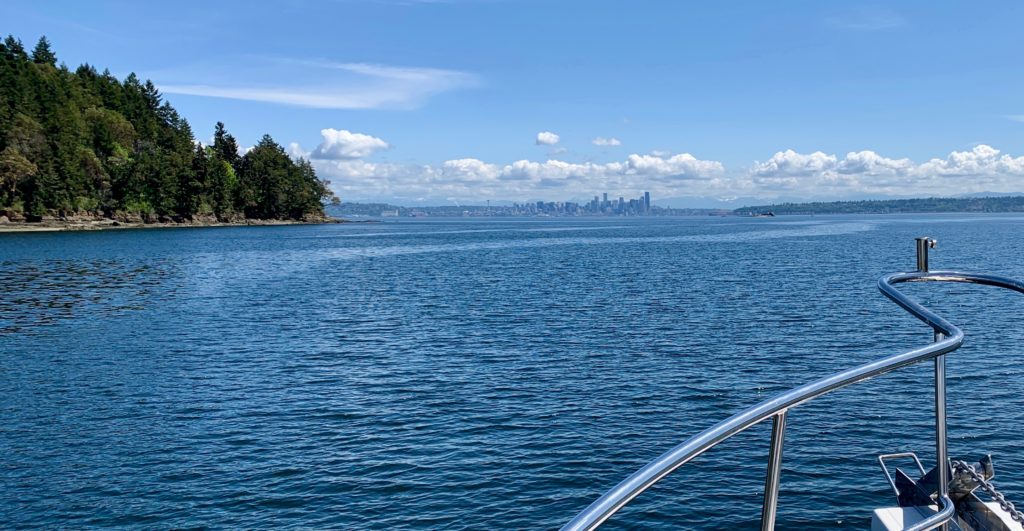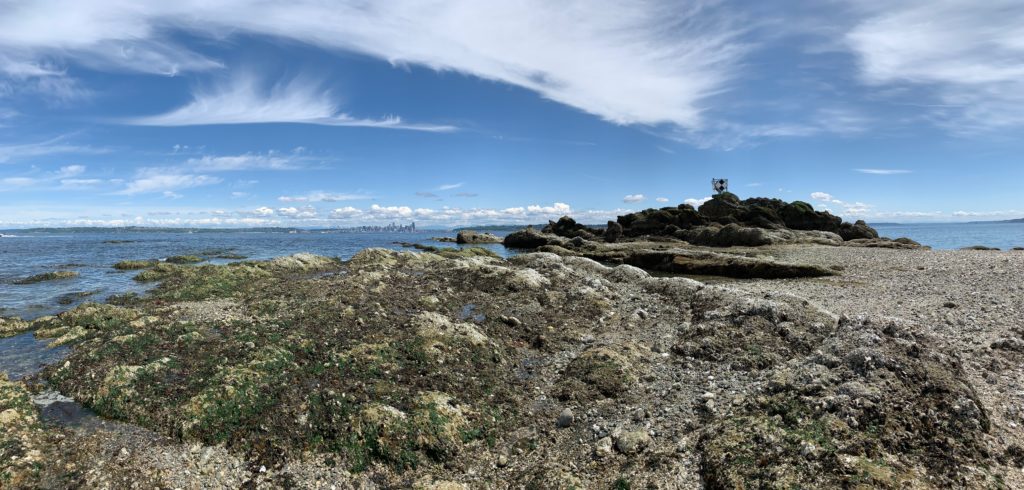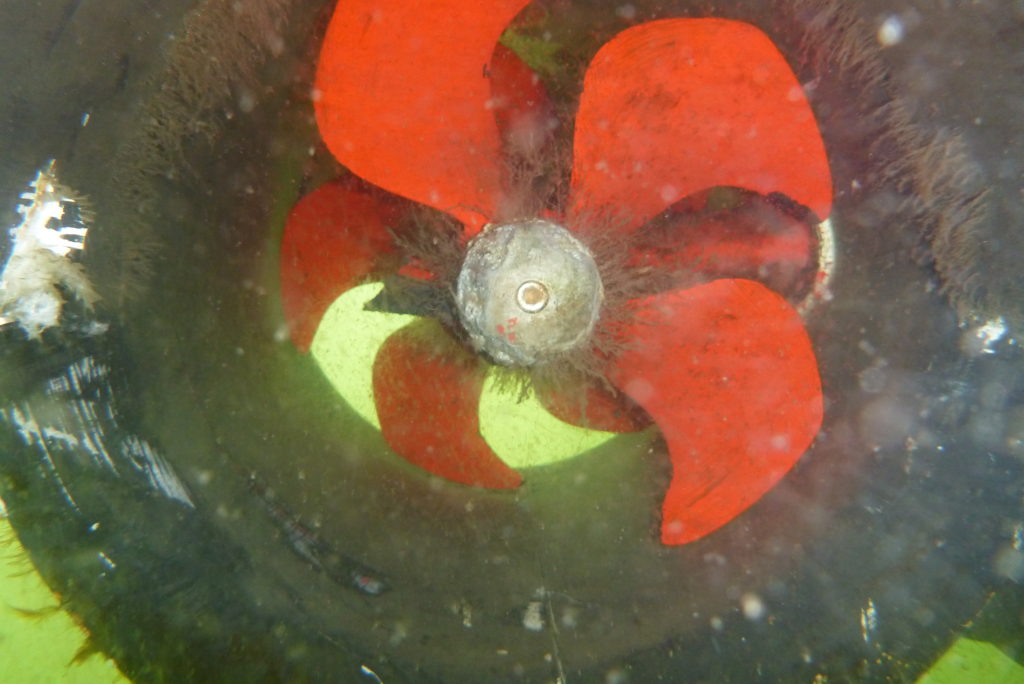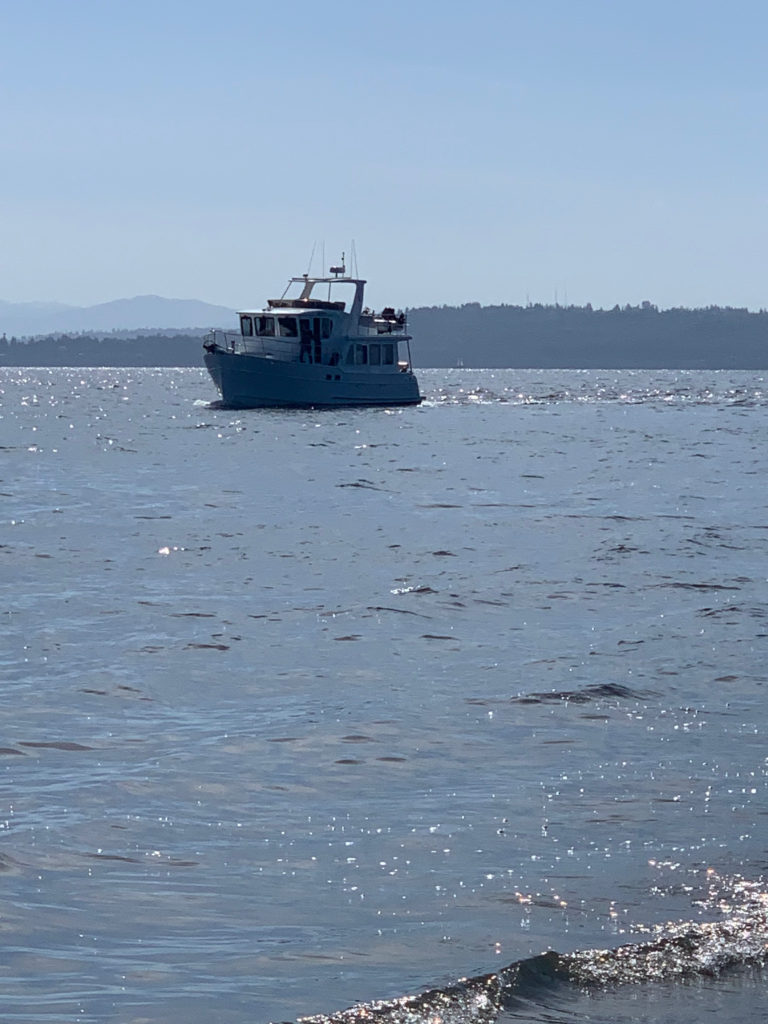Single-handing the boat on an overnight seemed like an important milestone. I wanted to prove to myself that I could manage various jobs by myself and get a feel for what it felt like to be at anchor alone. This may sound weird to some, but I haven’t spent a night away from my kids in years. I am on vacation this week, so my wife and I coordinated things so I could take a 24-hour mini vacation and test my skills (and face some anxiety).
Over all, the trip was a success, with one big hiccup. I decided to circumnavigate our home island of Bainbridge and drop anchor in a place we’d never been. On Monday, I headed down the east side and across the south end and dropped the hook in Blakely Harbor. Blakely is sheltered from the north and south and has a very nice view of the city to the east. I anchored for the night, explored by dinghy, had a relaxing dinner, then turned in early. The next morning I headed up the west side and docked without incident. Conditions were perfect for a solo trip.
What went well
- Got out of the marina and to the harbor with no issues. Pleasant cruise
- Dropped and set the anchor with no issues
- Dropped the dinghy and cruised around for a couple hours. Went tidepooling at Blakely Rock, visited a friend who lives on the water, explored Eagle Harbor
- Moved and reset the anchor when the current shifted and I noticed a very slow drag. The Garmin anchor alarm is buried behind 30 menus, but once it is set up it works well. After the second set, I didn’t move all night. I’m much more confident about anchoring, these days. I still make mistakes, but they’re recoverable and I am learning how to read the signs of a well- vs. poorly-set hook.
- Plenty of sun kept the batteries above 95% for most of the day
- Relaxing evening with plenty of peace and quiet. Replaced doomscrolling on my phone with reading a book on my kindle.
- Stowed the dinghy solo without issue
- weighed anchor without issue
- Saw my wife from the boat when she was out for a run along the shore
- Backed into my home slip with a 10 kt. crossbreeze solo (a neighbor was on hand in case things went sideways – literally). The trick I learned here is to not worry about the “neighbor side” of the slip. If I am 1-2 feet away from the dock, I have plenty of clearance to my neighbor. So, I don’t need to check out both sides of the pilothouse. Also, when I am the correct distance from the dock it actually looks way too close from the pilot house. So, I need to get used to that.
- Spent a few hours puttering around after docking – milked my vacation day to the max
What went poorly
- There was really only one thing, but it was a big deal for me. When I moved the boat to reset the anchor, I was towing the dinghy. When I used the stern thruster to reposition, it sucked in the line connecting the dinghy to the boat. I was able to cut it away, but it broke two fins off one of the thruster props. I emailed Trevor, who has become a reluctant therapist, and he said this is a common failure mode and the props are replaceable in the water. All in all it wasn’t a big failure, but it was hard to forgive myself, since line handling and keeping them out of the water and away from props is one of the very first seamanship skills you learn. I’m not hard on myself for honest mistakes, but when I know better and screw something up because I was being lazy or on auto-pilot I get really annoyed.
Food for thought
- I spent the whole night convinced I had damaged something permanently and wouldn’t be able to dock. In the light of day, I got a picture using my underwater camera and did some research. The breaker would have tripped before anything serious happened, and the prop is accessible enough that I might be able to replace it from the swim step. Every mistake is an opportunity for learning. This is a new failure mode.
- I don’t have enough spares. Spare thruster props should probably be standard kit. Even without leaving lines in the water, thrusters suck in anything nearby, making this a likely failure. It’s very hard to dock without them, so I should have them aboard. I should also have a spare pin for the dinghy prop. There are a lot of rocks around, and it only takes one to break a prop. This dinghy has oars, but it’s just not made for rowing. A $2 spare pin could make all the difference. Spares and knowing how to use them turn big failures into minor inconveniences.
- Lines are incredibly strong. The dinghy painter was about 1/4″, but my multi-tool knife couldn’t get through it. I had to use the saw and it took several seconds. I have a line knife aboard, but I don’t usually have it on me. This is probably a handy tool to keep on you, since, if you have to cut a line, something serious has happened.
- The sound of an anchor dragging from the V-berth sounds a lot like the sound of the chain just rolling over rocks. Either way the sound is conducted right up into the main cabin. While in bed trying to sleep, I kept hearing the telltale sound of chain on rock. I went up to the pilot house a few times to check the chartplotter, but she was holding tight. I know a lot of people who put instrumentation next to where they sleep to help with this – something to consider.
- Weighing anchor solo is easy, but if it’s muddy there’s really no way to wash it down. I went all the way home with a giant pile of mud on the anchor. Fortunately, the chain was clean, so it didn’t get into my locker.
- I had had one drink before dinner when I noticed I might be dragging. For a 180lb man, it’s not really enough to impair my judgement, but I usually never drink when I have anything important to do. When I reset the anchor, I didn’t take the time to walk around and make things ship-shape (like securing the dinghy). Since things can and do come up on the boat, drinking on a trip – even when at anchor – seems like a bad idea. After breaking the thruster, I’m even more convinced of that. Of course, having a sundowner is one of my favorite parts of the day. But, I think I need a checklist of sorts to make sure I can be off the clock when I have one.
Critical gear for single-handing
Turtle is well-set up for single handing. I also need a couple of improvements.
- Windlass control from the pilothouse with a chain counter.
- Chartplotter with anchor drag alarm
- Bow and Stern Thrusters with remote – so I can control it from the dock
- Power davit for getting the dinghy on and off
- Boathook – for many reasons
- Forward gate so I can climb down to the dock from the pilothouse. The porthole from the midship head doubles as a step. This isn’t ideal, but since the only way to the stern is through the main cabin it’s still the most direct way to the dock and the fastest way to get to the midship line.
- Underwater camera – I’m still using a cheap Panasonic I bought like 12 years ago and it still works great.
- Todo – backup camera. The one they install by default is on the hardtop. This along with the relatively low resolution makes it pretty worthless. Putting one on the roof of the cockpit will make this a ton easier. My neighbor (NP42 Well Seasoned) has a wireless one that even has backup guidelines.
- Todo – more spares


















I also recorded a video – which may or may not continue…
